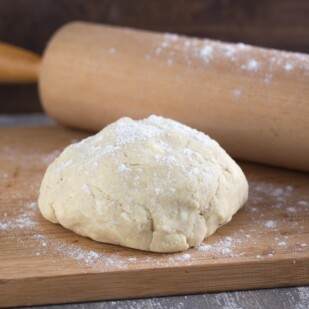Why Blind Baking Pie Crusts Is Important
Blind baking, also referred to as par-baking or pre-baking, ensures a crisp bottom crust in single crusted pies. This article presents everything you need to know about Blind Baking Pie Crusts.
Both rolled pastry-style crusts and pat-in crumb crusts can be blind baked and there is some overlap in technique, but there are also some techniques that are specific to each, so we will take them one at a time.
Blind Baking Rolled Pastry Crusts
Have you ever had a pie with a pastry crust where the bottom was soggy? Yes, us too. That can be prevented by partially baking the crust before the filling is added.
The trick is to keep the pastry from sliding down the sides of the pie plate and also from bubbling up excessively.
Let’s start with an oven preheated to 375°F/190°C with the rack in the upper third of the oven.
After fitting the bottom crust into your pie plate and fluting your edge, you can line the pie with a piece of aluminum foil, parchment paper or – our favorite choice – paper coffee filters. We pick them up at a dollar store and keep them around just for this task.
Then you need to fill the paper or foil with “pie weights”. There are commercially available pie weights, and you can see a metal chain as well as a silicone chain version in the image above, but you can also use dry rice or dried beans.
The idea is to create weight to keep the pie dough in place. If you want to use rice or beans, which can be re-usable, cool after using and store them in an airtight container for next time; do not cook them to eat.
I am partial to the metal chain style; they add weight and conduct heat, both of which are desirable.
If the recipe calls for par-baking, it means that you will be baking the crust just enough to set the crust as it will be going back into the oven after the filling is added.
In this case, you want to bake it until it is dry to the to the touch and just until it begins to color (this is the pie on the right in the top image).
Bake for about 10 minutes with the pie weights, then remove the paper and weights and bake for a few more minutes, or just until the crust colors.
If the recipe calls for a fully baked crust, proceed as above, but after you remove the paper and foil bake it until it is fully baked and a nice golden brown color (as seen on the left in the top image).
In most cases, you will completely cool the crust before proceeding but follow individual recipe instructions.
Blind Baking Pat-In Crumb Crusts
Some pies, such as our Lactose-Free Cheesecake Pie with Pomegranate, call for a partially baked crumb crust. Pat-in crumb crusts typically do not slump, so they do not have to be lined with paper and weights.
Patting them in firmly in an evern layer helps ensure great results. We like to use a flat-bottomed measuring cup to help press the crumbs into an even layer along the bottom and sides, as seen below.
You will, however, follow the instructions as above in the sense that you might par-bake the crust – if it is going to go back in the oven with a filling – or you might fully bake it. It is just a matter of timing. Bake until just beginning to feel dry and starting to color if you want it par-baked.
Keep it in the oven longer until completely baked if that is what you need. Easy peasy.











